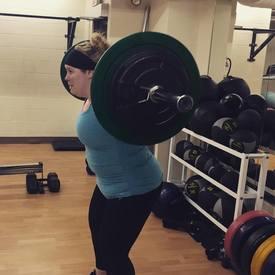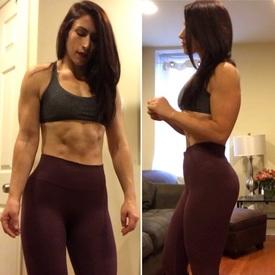Welcome to Debate Club! Please be aware that this is a space for respectful debate, and that your ideas will be challenged here. Please remember to critique the argument, not the author.
Fat, the new normal
Replies
-
NIH has standards for measuring frame size: https://medlineplus.gov/ency/imagepages/17182.htm However, the majority of weight is stored as fat and soft tissue.. not bone. Bones don't have large weight changes from small to avg frame size. Also--- for my height, 6'0, BMI says I can weigh 137-183 lbs. That's pretty much the same scale as that chart anyway.
0 -
What a load of hogwash. This chart gives a 5'8" woman with a large frame a maximum weight of 143 lbs.. or a BMI of 21.7 . There's NO statistical evidenced that a woman's weight needs to be that low. None. This recommendation skews to the lowest end of the healthy range of the BMI chart. Not even Asians, who have the lowest recommended body weights, have *quite* that low an upper limit.

It's pretty clear there's increased morbidity and mortality associated with very low body weights. And your charts recommend body weights low enough to be on the steep up-curve of morbidity and mortality, and say that weights that are clearly in the lowest morbidity/mortality region are overweight. (Lancet 2009; 373: 1083–96)
To illustrate how bad that chart is, this is me. I'm still overweight by that chart you've posted.
I love it. I, apparently, am 38 pounds overweight.8 -
While I agree that we are starting to accept higher and higher weights and bigger sizes and this is becoming a health issue for our society as rates of obesity are climbing, at an alarming rate.
However, here's where it's a hard sell: I have done a few Bod Pod sessions which are the ones where you sit in a capsule and it measures your weight and volume to determine your BF%. I am 5'10 and I have about 160lbs of LBM on me. On all of those scales, even if I could get down to 0% BF I am pushing the limits for what I should weigh. And body composition is important to consider when looking at someone's health. I am obviously not a petite woman, but I strongly believe 160 - 170lbs is unrealistic for someone with the body comp I have.1 -
Is this only about women?2
-
While I agree somewhat with the title of this post, that being overweight has been more normalized in today's society, that initial chart is pretty hilarious to use as the standard for your point. What the "fingers around the wrist test" seems to tell me is whether someone has long fingers or whether someone has short fingers.

As a "small framed" individual by those standards (no way am I small framed) weighing in at 143 pounds and approximately 17% body fat, i'm considered overweight for the small frame category and nearly overweight in the large frame category. It would be physically impossible for me to diet down 20 pounds to get to just the top end of that small frame range.3 -
I'm 5'11, currently 149 and my fingers overlap. But I have skinny wrists and long fingers. My shoulders and hips tell a different story though. After doing some logical digging I've determined that I'm "medium framed" and weigh the perfect amount.
I've been down to 143 before and I look sick. And it's hard to maintain. So if the whole fingers overlapping thing is true, I'd need to be MUCH lighter to be normal.1 -
NorthCascades wrote: »Is this only about women?
The chart in the OP is women-specific, yes. Is that your question? I mean, I'm sure body type by finger length and wrist girth is equally idiotic for men though. #feminism #shortfingersmeanimfat3 -
NorthCascades wrote: »Is this only about women?
Apparently. I'm not sure I've ever seen the "wrap your fingers around your wrist" test applied to men (maybe it has, and I've just missed it). Combined with the chart in the OP "most people" seems to be a euphemism, for "most women".3 -
What a load of hogwash. This chart gives a 5'8" woman with a large frame a maximum weight of 143 lbs.. or a BMI of 21.7 . There's NO statistical evidenced that a woman's weight needs to be that low. None. This recommendation skews to the lowest end of the healthy range of the BMI chart. Not even Asians, who have the lowest recommended body weights, have *quite* that low an upper limit.

It's pretty clear there's increased morbidity and mortality associated with very low body weights. And your charts recommend body weights low enough to be on the steep up-curve of morbidity and mortality, and say that weights that are clearly in the lowest morbidity/mortality region are overweight. (Lancet 2009; 373: 1083–96)
To illustrate how bad that chart is, this is me. I'm still overweight by that chart you've posted.
Its sillier than that, actually, when coupled with the truly idiotic finger/wrist test. It seems, per this test, I am large framed (I have large wrists, but a narrow pelvis). So this is underweight:
2 -
NIH has standards for measuring frame size: https://medlineplus.gov/ency/imagepages/17182.htm However, the majority of weight is stored as fat and soft tissue.. not bone. Bones don't have large weight changes from small to avg frame size. Also--- for my height, 6'0, BMI says I can weigh 137-183 lbs. That's pretty much the same scale as that chart anyway.
Wrist test: Still silly. In women, big stuff like pelvic width and breast size is going to make a lot more difference than wrists, when it comes to determining a sensible weight.
And where bones do matter - like pelvis - the relevant point is the span, because it takes materially more meat and skin to wrap a wide span than a narrow one. Yes, soft tissue - but not only fat. The point is not the size/weight of the bones themselves. (Does anyone ever question that men with wide shoulders might rationally weigh more than men with a more narrow/linear vs. top-wide/triangular build? I've never seen it discussed.)
Women my size can have breasts from at least 34A to 36 (or more) DDD and beyond. That's a multi-pound difference. (40B, when I was obese = about 4 pounds of breast tissue, according to my pathology lab).
At 5'5, I have wrists over 6.25. Large frame?
But at goal weight, I have 34" hips. There are women my height who'd need to be skeletally gaunt to get 34" hips, if they could get there at all. (I attached a photo upthread. I'm not skeletal.) I always had small breasts; now I have none (post mastectomies).
My wrists say "large frame". Common sense - and visual assessment of the results - say I belong near the low end of the BMI range.
The whole generic frame size paradigm is useless, IMO. We're individual.
Edited: typos12 -
NIH has standards for measuring frame size: https://medlineplus.gov/ency/imagepages/17182.htm However, the majority of weight is stored as fat and soft tissue.. not bone. Bones don't have large weight changes from small to avg frame size. Also--- for my height, 6'0, BMI says I can weigh 137-183 lbs. That's pretty much the same scale as that chart anyway.
Wrist test: Still silly. In women, big stuff like pelvic width and breast size is going to make a lot more difference than wrists, when it comes to determining a sensible weight.
And where bones do matter - like pelvis - the relevant point is the span, because it takes materially more meat and skin to wrap a wide span than a narrow one. Yes, soft tissue - but not only fat. The point is not the size/weight of the bones themselves. (Does anyone ever question that men with wide shoulders might rationally weigh more than men with a more narrow/linear vs. top-wide/triangular build? I've never seen it discussed.)
Women my size can have breasts from at least 34A to 36 (or more) DDD and beyond. That's a multi-pound difference. (40B, when I was obese = about 4 pounds of breast tissue, according to my pathology lab).
At 5'5, I have wrists over 6.25. Large frame?
But at goal weight, I have 34" hips. There are women my height who'd need to be skeletally gaunt to get 34" hips, if they could get there at all. (I attached a photo upthread. I'm not skeletal.) I always had small breasts; now I have none (post mastectomies).
My wrists say "large frame". Common sense - and visual assessment of the results - say I belong near the low end of the BMI range.
The whole generic frame size paradigm is useless, IMO. We're individual.
Edited: typos
This just inspired me to Google. Yep, a good 2-2.5kg of me is boobs. I'm smack bang in the middle of healthy BMI.2 -
I share peoples skepticism about the validity of the chart. However its good to know I have a medium to large frame... I always suspected as much lol (the width of my shoulders is the biggest tip-off)
I have no idea about the science behind this (if any) but do know I can look too skinny at the middle of the BMI range for my height.1 -
singingflutelady wrote: »lemurcat12 wrote: »I have long and skinny fingers, can easily stretch 10 keys on a piano and a frenemy in jr high claimed my hands looked like daddy long legs (I do have only 5 fingers on each hand, for the record, including my thumbs). I don't think I actually have a small frame, but apparently my long fingers mean that I am fat at 125 (I'm 5'3) and need to be 113 or less.
I think I'll stick with BF% and BMI, but thanks.
Finger twin! I definitely have pianist hands
Same here! And ZERO ability to play piano (I come from a heavily musical family, we tried. My brain can't do it.), so growing up being told that I'd be a tall (big hands and feet) pianist means that this 5'4"/163 cm girl got used to ignoring what others said at a pretty early age...0 -
Thankful that I've never cared about being normal. Healthy is my goal and healthy is what I am at 5'6" and 146.3 lbs (as of this morning).3
-
I'm still confused about why this thread was started.
Was the original chart really old and supposed to show that people used to think you had to be even thinner than we think now to be healthy?
I really don't have any idea what weight is supposed to be healthy for a woman. I had an ex that's about 5'8" and I've seen her weight fluctuate wildly. She looked her best when she was around 125 - 130, she was clearly overweight when she was in the 150ish range, and she was clearly underweight when she was around 115.
That experience is literally my only context for women's weight.2 -
I'm still confused about why this thread was started.
Was the original chart really old and supposed to show that people used to think you had to be even thinner than we think now to be healthy?
I really don't have any idea what weight is supposed to be healthy for a woman. I had an ex that's about 5'8" and I've seen her weight fluctuate wildly. She looked her best when she was around 125 - 130, she was clearly overweight when she was in the 150ish range, and she was clearly underweight when she was around 115.
That experience is literally my only context for women's weight.
A 5'8" woman would not be overweight at 150 (BMI of 22.8), though she might have been a little over-fat. At 125 her BMI would only be 19 and that is only 1.1 points from being underweight.
Are you sure she wasn't lying about her weight? Many women do.6 -
Need2Exerc1se wrote: »I'm still confused about why this thread was started.
Was the original chart really old and supposed to show that people used to think you had to be even thinner than we think now to be healthy?
I really don't have any idea what weight is supposed to be healthy for a woman. I had an ex that's about 5'8" and I've seen her weight fluctuate wildly. She looked her best when she was around 125 - 130, she was clearly overweight when she was in the 150ish range, and she was clearly underweight when she was around 115.
That experience is literally my only context for women's weight.
A 5'8" woman would not be overweight at 150 (BMI of 22.8), though she might have been a little over-fat. At 125 her BMI would only be 19 and that is only 1.1 points from being underweight.
Are you sure she wasn't lying about her weight? Many women do.
no, she was on obsessive scale watcher, so I know the weight was accurate. She had very little muscle mass, her LBM would have been well below average. At 150 she looked pretty heavy. Could have been in part due to how she carried her excess weight.2 -
My brother is the same height as me (174cm), same body fat (17%) but far more muscular adding to his weight (95kg) his BMI has him as obese scoring 31.3.
Whilst I sit at 17% BF weighing 78kg and Overweight with a 25.7 rating!
17% body fat on each of us, and we're both overweight apparently. (The body fat test was conducted at Loughborough University. it consisted of a blood test, a body composition scan (using a machine that does a 3d scan of your entire frame.) and also electronic body composition scale readings (bio-electrical impedance), finally a skin fold/pinch test was done using body fat calipers and the average result was taken.
We both were given the 17% body fat reading and the piece of equipment that was closest on us both was the bio-electrical impedance scan. (my next closest was the 3d, his was the skin fold)
This is why BMI and any other method are bull *kitten* as unless you take proper measurements, they're unreliable.3 -
NIH has standards for measuring frame size: https://medlineplus.gov/ency/imagepages/17182.htm However, the majority of weight is stored as fat and soft tissue.. not bone. Bones don't have large weight changes from small to avg frame size. Also--- for my height, 6'0, BMI says I can weigh 137-183 lbs. That's pretty much the same scale as that chart anyway.
Wrist test: Still silly. In women, big stuff like pelvic width and breast size is going to make a lot more difference than wrists, when it comes to determining a sensible weight.
And where bones do matter - like pelvis - the relevant point is the span, because it takes materially more meat and skin to wrap a wide span than a narrow one. Yes, soft tissue - but not only fat. The point is not the size/weight of the bones themselves. (Does anyone ever question that men with wide shoulders might rationally weigh more than men with a more narrow/linear vs. top-wide/triangular build? I've never seen it discussed.)
Women my size can have breasts from at least 34A to 36 (or more) DDD and beyond. That's a multi-pound difference. (40B, when I was obese = about 4 pounds of breast tissue, according to my pathology lab).
At 5'5, I have wrists over 6.25. Large frame?
But at goal weight, I have 34" hips. There are women my height who'd need to be skeletally gaunt to get 34" hips, if they could get there at all. (I attached a photo upthread. I'm not skeletal.) I always had small breasts; now I have none (post mastectomies).
My wrists say "large frame". Common sense - and visual assessment of the results - say I belong near the low end of the BMI range.
The whole generic frame size paradigm is useless, IMO. We're individual.
Edited: typos
Can I add things like shoulder width to this assessment? I have crazy broad shoulders, large breasts, tiny wrists, knobby knees and broad elbows ... and narrow hips and ribs.
Where does that put me on these charts?
I feel like my skeleton could be displayed in one of those carnival sideshows!
I Googled. Boobs are 3.3 pounds.
0 -
I'm still confused about why this thread was started.
Was the original chart really old and supposed to show that people used to think you had to be even thinner than we think now to be healthy?
The original chart is old, maybe the insurance charts?
I interpreted it to be saying that yes, you have to be thinner in many cases than the BMI would say in order to be a healthy or normal weight.
It's all silly since BF% makes more difference. I had a former trainer, same height as me (5'3), who was around 135 and looked thinner than I did at 125, because lower BF, more muscle. I don't believe her "frame" was particularly different than mine.4 -
So many people still focus on one number—total pounds—ignoring how many of those pounds belong to muscle, bone, organs, etc.
I always wished mfp would make it easier to focus on metrics other than total weight. For example, if you lost inches on your hips, it would be great to have an automatic status update that shares that. Conversely, if your goal is to gain muscle it could share status updates when you increase inches.1 -
IMO The only realistic way to project someone’s “ideal” weight is to measure body fat and muscle mass and work from there. I did 12 body composition assessments this week. I didn’t once look at the BMI portion of the reports when I discussed the results with members.2
-
Fascinating discussion and information, thanks everyone!0
-
I came in here fully expecting to agree with the OP, but this is just no. I am 5'3" and apparently I am overweight at 115.2. In my profile picture I was 120. My size 2s are getting loose on me and I need to drop two more pounds to be at the top weight for my height? Yeah, no.4
-
I don't think that chart OP posted is a good example. At my lowest weight of 120lbs I was unable to touch my finger to my thumb around my wrist. Now at 147lbs (working on dropping more!) I still can't do it. My wrist is a very boney part of my body. Not everyone has the same bone size or the same finger size.1
-
-
Cool thread, needs moar chart.0
-
I suppose it depends on a lot of factors that are just now being taken into account.
eg, 23andme:
"your genes predispose you to weigh about 8% more than average"
https://permalinks.23andme.com/pdf/23_17-GeneticWeight_Feb2017.pdf
So if you're predisposed to weigh more, you would likely want to consume 10% less calories than what a guideline states for your BMI to achieve the target. But you wouldn't even know about this unless you had a DNA test looking for it, and most DNA tests are more concerned with genealogy before they look at anything else. There may still be a lot more gene-centric reasons for having a certain body mass.
Another problem is vanity sizing by clothing manufacturers. By trying to make women feel good by giving arbitrary sizes (small/medium/large) or pointless dress sizes (eg 4 - petite) that have no standardized fit, it's instead feeding a negative feedback loop where people won't believe they are overweight as long as they still fit the dress sizes they used to wear. Meanwhile mens clothing is measured in inches or centimeters. So men are quickly told they are fat by the very same manufacturers where it's not measured in arbitrary small/medium/large sizes. That doesn't even get into teen or unisex sizes.
So while it might be ideal for everyone to have a BMI under 25 but above 20, that will just not be reality, and it is not a definition of "fat", it's simply a risk scale.
https://www.nhlbi.nih.gov/health/educational/lose_wt/risk.htm#limitations
"BMI is a useful measure of overweight and obesity. It is calculated from your height and weight. BMI is an estimate of body fat and a good gauge of your risk for diseases that can occur with more body fat. The higher your BMI, the higher your risk for certain diseases such as heart disease, high blood pressure, type 2 diabetes, gallstones, breathing problems, and certain cancers."
So if you have a BMI over 25 and you're not a body-builder, that might be an issue. People who are into body building, or are very athletic will certainly hit BMI's that have no bearing on reality. Likewise people who are not of European descent have different BMI medians. From that PDF above:
Median BMI
European 25.75
Latino 25.85
African-American 27.49
East Asian 22.65
South Asian 24.27
As for the the original post, I can touch my thumb and forefinger around my wrist. People do have different length digits, and I doubt this is a meaningful measure of anything.
0 -
This content has been removed.
This discussion has been closed.
Categories
- All Categories
- 1.4M Health, Wellness and Goals
- 398.1K Introduce Yourself
- 44.7K Getting Started
- 261K Health and Weight Loss
- 176.4K Food and Nutrition
- 47.7K Recipes
- 233K Fitness and Exercise
- 462 Sleep, Mindfulness and Overall Wellness
- 6.5K Goal: Maintaining Weight
- 8.7K Goal: Gaining Weight and Body Building
- 153.5K Motivation and Support
- 8.4K Challenges
- 1.4K Debate Club
- 96.5K Chit-Chat
- 2.6K Fun and Games
- 4.8K MyFitnessPal Information
- 18 News and Announcements
- 21 MyFitnessPal Academy
- 1.5K Feature Suggestions and Ideas
- 3.2K MyFitnessPal Tech Support Questions





























